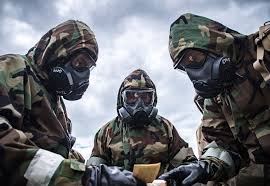In a proactive move to enhance national security, Belgium has ramped up its preparedness for Chemical, Biological, Radiological, and Nuclear (CBRN) attacks by conducting intensive drills aimed at improving the country’s response capabilities. These drills, which simulate real-world CBRN attack scenarios, reflect Belgium’s commitment to safeguarding its population and critical infrastructure from emerging threats. With the increasing global risks of terrorism and weapons of mass destruction, this initiative is a critical step in ensuring that Belgium remains prepared to handle CBRN threats effectively.
The Importance of CBRN Preparedness
CBRN incidents, though rare, represent one of the most significant challenges to national security. The potential consequences of such attacks are devastating, ranging from widespread contamination to long-term health hazards and disruption to vital services. With recent global developments in biosecurity and the continuing threat of chemical warfare, countries around the world are revisiting their emergency response protocols and enhancing their capabilities in managing these complex threats.
Belgium, which has been a key member of NATO and the European Union, recognizes the need to strengthen its national security infrastructure in response to the growing CBRN risks. The nation’s authorities have been working closely with experts, military personnel, emergency services, and international organizations to improve preparedness and response strategies for potential CBRN incidents.


The Drills: Simulating High-Stakes Scenarios
Over the course of the past few weeks, Belgium has conducted a series of high-intensity CBRN drills, designed to simulate various types of CBRN attacks and test the country’s readiness at every level of government. These exercises have included simulated chemical spills, biological attacks, and nuclear contamination events, testing the response capabilities of emergency responders, local authorities, military personnel, and health services.
One of the primary goals of these drills is to assess the coordination between various agencies involved in emergency response efforts. The country’s emergency services must work in tandem with the military, health departments, and local government bodies to ensure that the population is swiftly and effectively protected in the event of an attack.

The drills have also focused on the use of specialized CBRN equipment, such as decontamination units, protective suits, and detection devices, ensuring that Belgium’s first responders are fully equipped to handle any CBRN threats they may face.
Key Focus Areas of the Drills
The CBRN drills have been designed with several key focus areas to ensure a comprehensive approach to disaster management. These include:
- Detection and Identification: The drills focus on the early detection of CBRN substances, which is crucial in preventing the spread of contamination. Special attention is paid to the use of advanced sensors and monitoring systems to quickly identify and assess the nature of the threat.
- Decontamination Procedures: One of the most vital aspects of CBRN preparedness is ensuring effective decontamination procedures are in place. The drills test the capacity of decontamination teams to handle large-scale contamination and safely remove harmful substances from affected areas.
- Medical Response: Given the potentially devastating health effects of CBRN attacks, Belgium has emphasized medical preparedness in its drills. Emergency medical teams are trained to treat victims of chemical exposure, biological infection, or radiation sickness, ensuring that affected individuals receive timely care.
- Public Communication: Effective communication with the public during a CBRN incident is essential for ensuring public safety. The drills test Belgium’s ability to disseminate information quickly, providing citizens with clear instructions on evacuation, sheltering, and protective measures.
- Interagency Coordination: Given the complexity of managing a CBRN event, the drills place heavy emphasis on coordination between military, civilian, and emergency response teams. Ensuring smooth collaboration among these different bodies is key to managing the situation and minimizing harm.
The Role of Technology and Innovation
Belgium’s preparedness efforts also highlight the growing importance of technology and innovation in responding to CBRN threats. Over the past few years, the country has invested heavily in state-of-the-art detection systems, robotic decontamination units, and advanced medical technologies. These innovations have the potential to save lives, minimize environmental damage, and allow first responders to operate in high-risk environments with greater safety and efficiency.
Additionally, Belgium has made significant strides in biosecurity, particularly in light of the COVID-19 pandemic. This has involved strengthening laboratories, improving response protocols for biological threats, and investing in research related to the development of vaccines and treatments for potential bioterrorism incidents.
Belgium’s use of simulation technologies in its CBRN drills has also enabled responders to train in a controlled, risk-free environment. Virtual reality and augmented reality tools are increasingly being used to simulate hazardous scenarios, allowing emergency personnel to prepare for worst-case scenarios without endangering lives.
Collaboration with International Partners
Belgium is not working in isolation when it comes to CBRN preparedness. The country has been collaborating with international partners, including NATO, the European Union, and neighboring countries, to enhance collective defense and security. Joint exercises, information-sharing initiatives, and cross-border training programs have been essential in strengthening Belgium’s overall defense against CBRN threats.
This collaboration is particularly important, as CBRN incidents often have regional or global consequences. Sharing expertise and resources with neighboring countries helps create a unified, coordinated response in the event of a large-scale attack.
The Growing Need for CBRN Preparedness in Europe
Belgium’s investment in CBRN preparedness comes at a time when European countries are increasingly focusing on the threat of chemical, biological, radiological, and nuclear weapons. Over the past decade, Europe has seen several high-profile incidents involving chemical weapons, including the poisoning of former Russian spy Sergei Skripal in the UK, as well as growing concerns about biological and nuclear threats.
With its location at the heart of Europe and its role in international diplomacy and defense, Belgium is uniquely positioned to lead efforts in enhancing CBRN readiness across the continent. By investing in robust preparedness systems and conducting rigorous training exercises, Belgium is setting a high standard for other European nations to follow in the fight against CBRN threats.
Conclusion: Ensuring a Safer Future
Through its intensive CBRN drills and strategic investments in preparedness, Belgium is sending a clear message about its commitment to national security. The drills not only strengthen the country’s ability to respond to potential CBRN attacks but also highlight the importance of preparedness in safeguarding the health and safety of the public. As global threats evolve, Belgium remains dedicated to enhancing its defense systems and collaborating with international partners to ensure a safer, more resilient future.
Do follow Uae stories for more Updates
Pakistan Deputy Prime Minister Invites UAE Firms to Invest in Telecom Sector














